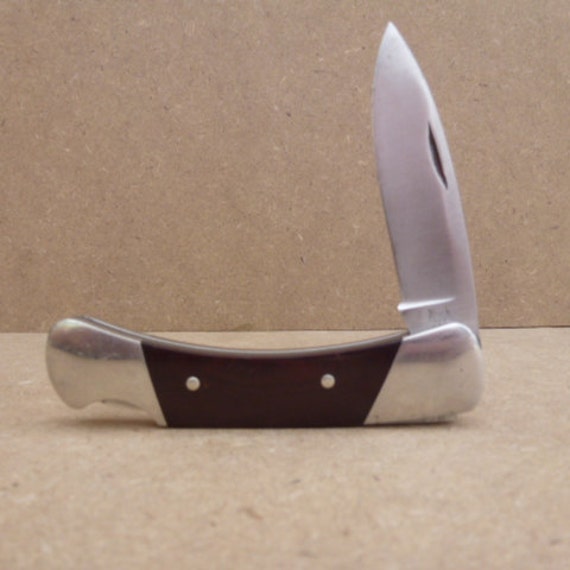Yes, there is a particular reason.
Buck changed to their super hollow grind with about a 12° per side edge bevel in about 2000. In the late 1990s Buck did a large project using a CATRA test machine to determine what blade profile would give the best performance. They found that the current blade profile gave superior results. They rolled it out with the name "Edge 2000".
The CATRA machine is a cutlery industry standard machine for comparing
cutting performance. You can read about it here:
http://www.catra.org/pages/products/kniveslevel1/slt.htm
Here's the thread from 2001 in which CJ Buck talks about the work that Buck did:
http://www.bladeforums.com/forums/showthread.php/127499-CATRA-Edge-Testing-Results
Unfortunately, the graphs no longer show. But, the upshot was that a BG-42 blade of the previous blade profile was outperformed by a 420HC blade of the new profile.
Personally,
I find that a flat grind is better for peeling apples. But the new profile performs better for most other tasks.
Frank, I too find that different grinds do different things better (like peeling apples) but reach a different conclusion.
I think by "cutting performance" you mean the ability to continue making straight cuts and the apex degrades, which is what the CARTA machine tests for. While this is an important aspect of overall blade performance for a particular cutting task, it is only one aspect.
Occasionally (less currently than I like), I find myself sitting and making shavings and the result is a wind spiral. It keeps my hands busy and my busy mind calm when just sitting on the porch or a beach. I find that it gives me a good way to get to know a knife in a way that corresponds to
my actual use, since outside of food prep, cutting wood is my #1 cutting task. I find that knives that do well making wind spirals do well working around my property and other wood cutting.
This also gives me a way to try different knives side by each. I'll often work on a spiral with 2 or 3 different knives to see if I can detect a noticeable difference in how they work the wood. I don't have a huge collection of knives, so this is not a huge list, but here are some of the knives that I've used in these side by side tests.
+ Buck 110 (hollow grind)
+ Buck 500 (hollow grind)
+ Buck 112 (hollow grind)
+ Buck 442 (hollow grind)
+ Buck 486 (hollow grind)
+ Case 316-5 (hollow grind)
+ Schrade-Walden H-15 (convexed sabre grind)
+ Opinel #9 & #10 (convex grind)
+ Mora Companion HD (factory zero grind Scandi)
+ Mora Companion HD (reground to convexed Scandi)
Here's a shot of the Mora with the shoulder convexed off (since polished out)
 image
image by
Pinnah, on Flickr
And a shot of an Opinel #10...
 Getting acquainted
Getting acquainted by
Pinnah, on Flickr
I don't have any pictures of any of my hollow ground knives making wind spirals because I never have been able to finish the job with them. Each and every time the flatter and more convexed blades do a better job and not by just a bit.
In reflecting on why this is the case, I find that the hollow ground knives seem to have a single "bite angle" when they start to bite into the wood and they feel like they continue to dive into the wood at that angle despite my effort to control the depth of the shaving. I had the same problem with factory zero grind Scandi on the Mora when new. This went way for me when I rounded off the shoulder of the Mora.
I *think* the rounded shoulder on the convexed Mora and H-15 and the lack of distinct shoulder on the Opinel allows me to use the shoulder of the blade as an easy to control fulcrum, which makes it easier to control the bite angle. I wonder if a similar thing is happening when you peel apples with a hollow ground blade?
I keep a couple of traditional knives in my kitchen drawer and use them (for fun, they make me happy) regularly. The Schrade 51OT is flat ground and of course the Buck 110 is hollow ground. The Opinel #9 and Buck 500 are my 2 EDC knives (in rotation) and they get used too (after being washed).
 image
image by
Pinnah, on Flickr
Tme and time again, I can notice a real difference in what sorts of food the different knives seem to be best at. The Buck 110 (and other hollow ground knives) do great with meat but they bind up noticeably when cutting things like onions, potatoes or squash. The flat Schrade and the thin convex Opinel slice much better. A really noticeable difference. Going beyond this, while the superiority of the flatter blades for slicing is huge, the superiority of the hollow grind for cutting meat isn't as noticeable.
I'm not suggesting that the CARTA test is meaningless. Only that edge retention is only a single aspect of overall blade performance. How the blade performs and handles when cutting matters too and what we cut may differ. For food and wood, I find the flatter or more convexed blades to be more versatile but again, this is YMMV territory.
Last comment on this front... Especially when working with wood I find it takes a day of cutting for me to find the feel of a blade. As with bike and ski handling, this suggests to me that there is a big connection between performance and user technique and with habitual technique, it's very possible for different people with different muscle memory will end up with difference preferences. These knives might work best for me and my hands and perhaps not for somebody else.







